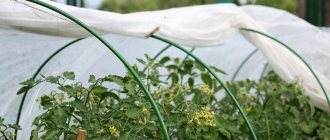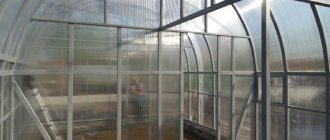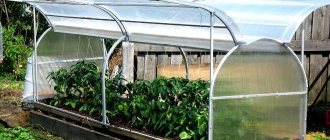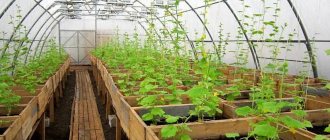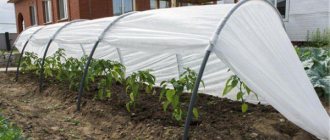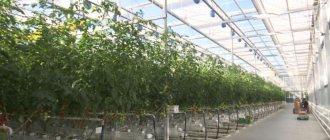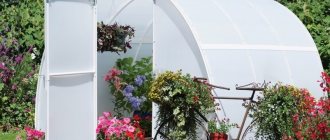The main differences between greenhouses and greenhouses
Greenhouses and hotbeds are very similar only at first glance; there are many differences between these garden structures. Greenhouses are structures of a simpler design that receive both solar heat and heat from rotting manure. Seedlings are planted on top of the manure over a small layer of soil. The height of greenhouses usually does not exceed one meter, and they are covered with wooden frames filled with glass.
Greenhouses with film are much cheaper than greenhouse structures due to the lower cost of film compared to any glass and due to the fact that they do not require the manufacture of a durable frame. In heating a film greenhouse, instead of horse manure, more modern heat sources are used, which significantly reduces the labor costs for its construction.
Greenhouses, compared to greenhouses, are more recent inventions, built in the form of greenhouses for exotic plants. The significant height and the presence of doors make caring for crops in a greenhouse much more convenient than in a greenhouse, where frames must be removed each time. The covering of greenhouses and greenhouses is currently most often made of polyethylene film.
What to consider when building a film greenhouse
Currently, the chemical industry produces high-quality stabilized films with a long service life (up to eight years). Typically, polyethylene film is produced in different thicknesses and densities (maximum up to 300 microns), but the thicker it is, the better, otherwise it will quickly be torn by the wind, so for constructing greenhouses you should choose polyethylene with a thickness of at least 200 microns.
It should also be taken into account that the higher the greenhouse, the more it will be affected by the wind. Therefore, it is advisable to dismantle the film for the winter. If this is not done, it will quickly deform under the influence of precipitation (rain and snow).
During installation work, individual pieces of polyethylene are usually soldered with a special soldering iron for welding films (it is advisable to solder the joints with an overlap, which should be about 25 centimeters for reliability).
If you decide to install the film immediately and for a long time, you will have to take care of a fairly strong metal profile, which will significantly increase the cost of the entire structure.
In any case, the frame must be reliable to withstand gusts of strong wind, so it will have to be strengthened with additional jumpers in different planes so that the structure becomes monolithic and solid.
Care should also be taken to protect all metal elements from unwanted corrosion.
Film greenhouse on a summer cottage.
Film greenhouse size
It is desirable that the greenhouse frame does not contain internal pillars (supports). This is important if you decide to use small-scale mechanization equipment (motor cultivator or walk-behind tractor) to cultivate the soil inside the building.
Not only will additional supports take up useful space inside, but they can also be breeding grounds for various pathogenic microorganisms. For this reason, when planning a greenhouse, it is better to initially consider a hangar-type construction (without internal supports).
The usual size of greenhouses is 6x12 meters. A six-meter width will not lead to sagging of the film and the formation of unwanted depressions with puddles on the roof of the building.
An indicator such as the height of the greenhouse is also important, since the more air there is inside, the more energy will be spent on heating the room. However, when using mechanical means of soil cultivation, this factor should also be taken into account.
The greenhouse should be comfortable, so usually the height inside rarely exceeds two and a half meters.
Film greenhouse shape
To prevent the accumulation of water on the roof, the top of the greenhouse should be built either with a single slope (which, for obvious reasons, can cause some inconvenience to the people inside), and preferably with a gable slope, or an arched one. In any case, the height will be different in the center and on the sides inside the greenhouse, so where there is less space it is advisable to place low-growing plants.
Ventilation of film greenhouse
When building a greenhouse, special attention should be paid to this factor. You can often observe how, in order to ventilate such greenhouses, some people open the film from the ends or sides of the building, which is fundamentally wrong, since ventilation must be done in the upper part of the building (at least two meters). This will prevent various harmful insects from getting inside the greenhouse: aphids, weevils, beetles, larvae and other pests and disease carriers.
You should also take care in advance of irrigating the plants (supplying water) and additional heating of the room in case of frost.
It is important to constantly maintain cleanliness and order inside the greenhouse, so from time to time all surfaces inside the building should be disinfected.
For the same reason, it is advisable to restrict access to the premises by unauthorized persons, and a special mat soaked in a disinfectant solution should be placed at the entrance.
Pros and cons of greenhouses
The main material for covering greenhouses was initially glass, then it began to be replaced with light and cheap polyethylene. Glass structures are very heavy; the frame for them is made of durable material.
The main advantages of covering a greenhouse with film compared to glass and polycarbonate floors:
- the film has no leaks or places of convective heat loss;
- much cheaper than all other transparent heat-shielding materials;
- frame structures for film can be made from materials of any composition; there are no special strength requirements for them;
- constructive simplicity of manufacture - the simplest frame can be made yourself in the form of separate arcs connected to each other at the top. These arcs do not have to be installed strictly level;
- The heat loss of a film greenhouse does not depend on the correct geometry of its frame structure. Glass greenhouse structures in places where the glass does not adhere well to the frames can lead to significant heat losses.
The disadvantages of film greenhouses include the following features:
- fragility;
- low resistance to wind loads;
- lower ability to transmit sunlight compared to glass or polycarbonate;
- high thermal conductivity of the coating.
By comparing the listed pros and cons, we can conclude what material is best to build everything from and which greenhouse is better - polycarbonate or film. If you have sufficient funds and want to make a durable greenhouse, you can choose glass or polycarbonate. And when funds are limited, film is the main material that allows you to get a good result at low cost.
Rules for placing greenhouses and greenhouses
To place a greenhouse on a site, it is necessary to choose a place to which large amounts of manure can be transported and subsequently removed. For a greenhouse, it is very important that the slope of the glazed frames be oriented towards the sunny side. Considering that when constructing a greenhouse, soil is excavated in large quantities, a place for this is chosen with a deep soil layer.
For a country greenhouse under film, it is not very important which side it faces the sun, because the light passes to the plants from all sides equally. It is only important that it does not end up in a place where it is shaded by another, higher structure. It is irrational to place it under trees, since their branches will also absorb a significant amount of sunlight.
A great danger to crops in film shelters comes from high groundwater, which can contribute to rotting of plant roots and waterlogging of the air. It is necessary to choose a place on a summer cottage where groundwater is far from the soil surface.
How to choose the best film for greenhouses
Modern innovative production has allowed companies to produce various types of films that differ not only in technical characteristics, but also in color. Along with traditional transparent or white canvases, today you can purchase colored materials that are aimed at refracting sunlight in order to change the shade, which will help increase the yield of grown vegetables. In cloudy weather, vegetables experience a deficiency of yellow and red colors, so multi-colored film can eliminate this deficiency. As for other parameters for choosing material for greenhouses, experts also recommend paying attention to:
Types of frames
Modern industry produces frames for greenhouses under film in a wide range. The main differences between such frame structures are the material of manufacture and the shape of individual elements. When thinking about how to build a greenhouse with your own hands from wood and film, you must not forget that there are more modern materials for greenhouse frames that are cheaper than wood and have excellent performance qualities.
Wooden
Most often, craftsmen at home tend to make wooden greenhouses from film with their own hands. To do this, there is no need to have a welding machine and a grinder and be able to use them. Often, a wooden frame is made from waste generated during various construction works.
The most commonly used wooden materials for greenhouses are:
- board;
- beam;
- rail;
- old window frames.
There are almost no complaints about the strength of materials for frames of film structures. What is more important is how to secure the film to the greenhouse. It is also important that the frame elements have no sharp protruding elements and that they hold screws and staplers well.
Steel
It is more difficult to make a steel structure than a wooden one. At dachas there are greenhouses made of reinforcement under the film, made using arc welding. Often, steel waste from various construction and installation works is used to make greenhouses:
- round pipes;
- corners;
- rods;
- stripes;
- profiled pipes.
From these profiles, industrialists make galvanized greenhouses under film in various modifications. To manufacture a steel frame, you need the ability to use a welding machine and tools for cutting steel blanks to specified sizes. Compared to wood, steel frame construction has a significantly longer service life and increased strength. Its disadvantage is the difficulty of attaching the film to the metal frame of the greenhouse and installing elements for fixing the film covering to the load-bearing elements.
Aluminum
Aluminum frames are good because they weigh significantly less than steel structures. A greenhouse made of aluminum can be easily moved to a new location; its elements do not become rusty and have a better aesthetic appearance.
In construction stores and retail stores there are now enough types of aluminum profiles for the manufacture of prefabricated greenhouses for film. The main disadvantage of this design is the inability to use a conventional welding machine in its manufacture. You can attach frame elements to each other at home only with the help of self-tapping screws or special connecting elements.
The rigidity of the frame for the film made of aluminum elements is quite sufficient if you use blanks of the required cross-section for their manufacture. How to make a greenhouse from metal and film, watch the video:
Plastic
Often, a greenhouse under film is made with your own hands from plastic elements. The lightest frames for film greenhouses are made of plastic pipes; they are very easy to manufacture, do not require additional processing, are not heated by the sun and are easily bent along a given radius.
|
The plastic elements of the greenhouse frame are not subject to corrosion, making them durable in use, and it is very convenient to use them to make dismountable greenhouses for film. They can withstand any humidity and large temperature changes, and are not afraid of atmospheric factors.
The plastic elements of the greenhouse frame are fastened using special clamps made for plumbing purposes. Considering the low cost of plastic pipes, this is a very good material for the manufacture of any film structures.
Combined greenhouses
To reduce the cost of construction, many gardeners use a combination of different materials. The following combinations are often taken:
- polycarbonate and glass;
- covering material with polycarbonate;
- film and agrofibre.
The most popular is a combined greenhouse made from old frames on the sides and polycarbonate on the roof. Old frames are inexpensive and easy to buy. People who are replacing the glazing in their apartment with double-glazed windows and do not have a summer cottage will be happy to sell you the old glazing at an affordable price. The roof can be made of an arched type and covered with cellular polycarbonate. The design will be inexpensive and have a low specific gravity, which will allow you to avoid spending money on arranging a capital foundation. This material is combined when arranging poultry houses.
An example of a combined greenhouse made of wood and corrugated polycarbonate
A construction made from film and agrofibre is inexpensive. In addition, condensation will not accumulate in such a greenhouse, since agrofibre is a breathable material. Also, this design will not be hot in the summer heat; agrofibre will protect the plants from frost.
If you remove the material for winter storage, it can be used for several seasons. The frame can be made of any light material except metal. No foundation is needed for the structure.
Also, the use of this combination of materials will help make a mobile greenhouse that can be installed in different parts of the site.
Methods of attaching film to a greenhouse
There are many ways to attach the film to the greenhouse frame. This can be done with the help of improvised materials found in the household, and by using special fasteners for greenhouse film, sold in hardware stores. In any case, the fastening must ensure reliable retention of the coating on the frame even in extreme weather conditions. After all, if the covering is torn off by the wind, the plants will inevitably suffer, and the planned harvest will not be obtained. How to fix the film on a greenhouse made of arcs is a very important question for those who have decided to grow plants in greenhouse conditions.
The main methods of attaching the film to frame elements:
- using wooden slats to a wooden frame;
- PVC clips for greenhouse film and galvanized steel or aluminum profile;
- a mesh fixed to the base of the frame and thrown over a film covering;
- eyelets and elastic cord.
Gardeners and summer residents often come up with their own, completely reliable methods of attaching film to the elements of the greenhouse frame, often using materials that are widely available in retail chains. If these methods hold the coating well on the frame and do not lead to damage to it, then such inventions are fully justified. Attaching the film to the frame of the greenhouse is the most critical moment of its construction. If everything is done reliably, the greenhouse will last for the required period without requiring annual repairs of the frame and covering.
Lath, option for wooden frame
|
The easiest way to attach the covering material to the frame of a wooden greenhouse is with a wooden batten. With their help, even a prefabricated greenhouse under film can be made. By placing slats on the elements of a wooden greenhouse roof and screwing them with self-tapping screws, you can get an excellent fastening option.
It is important that the surface of the wooden frame elements and covering slats is well processed and does not contain roughness or protruding knots. The sizes of the screws are selected so that they do not protrude from the other side of the frame elements and do not split the covering slats. If the wood of the slats is overdried and fragile, before attaching the covering using self-tapping screws, holes should first be drilled in it according to the diameter of the self-tapping screws used.
Lath nailed at the ends
In order to securely attach the film to the top of the greenhouse using wooden slats, you need to come up with an original way to reach there with a working tool. More often, in wooden frames, film fastening is used with slats nailed at the ends. This method saves the builder from having to reach with a screwdriver into inaccessible places in the structure, risking falling through and tearing the coating.
|
When securing the film only at the ends of the greenhouse, it is necessary to tightly tension the top of the covering, since if the tension is poor, the film will blow up with the wind and tear.
When fixing the film only on the end sides, in addition to tension, you need to ensure that there are no sharp corners or protruding edges on the frame elements. Additionally, it is recommended to stretch a mesh or some other fastening for the film onto the greenhouse along the top. Small gusts themselves are dangerous because when they form, the film quickly breaks and the entire greenhouse gradually opens up.
Clamps, clips - an option for a frame made of PVC pipes, fittings
Regardless of the material of the structural elements of the frame, you need to choose a method of fastening the coating that will prevent breaks in it and unforeseen heat losses.
If the film greenhouse is made of PVC pipes or steel reinforcement, special clamps and clips must be used to secure the covering layer.
Clips for attaching film to a greenhouse are classified according to the location of attachment:
- for fastening material to round pipes;
- to profiled pipes;
- to other shaped elements of the frame structure.
At an inexpensive price, these products greatly simplify the work of constructing a greenhouse covering and make it more reliable.
Film fixation systems for greenhouses
A more expensive and reliable way to attach the covering of a collapsible greenhouse under the film is the covering fixation system. They usually consist of special metal profiles and PVC clips that are resistant to ultraviolet radiation from the sun. The profiles provide shapes on which clips for the film will be conveniently and securely fixed to the greenhouse, pressing the covering on top.
In the fixation systems, it is thought out in detail how to attach the film to the metal frame of the greenhouse; the entire process of attaching the greenhouse covering is well developed, in which there will be no damage to it during installation and during the service of the structure. Clips hold the film both on the roof of the structure and on its side and end surfaces.
Double clips are often used on aluminum profiles, which are the simplest and most reliable way to attach the film when assembling a structure in the spring and when dismantling it in the fall. It is somewhat more difficult to produce a greenhouse cover with a double film intended for growing crops at an earlier date. But, if everything is thought out and calculated in advance, no special difficulties arise with this design.
Advantages of film greenhouses for growing crops
When professional vegetable growing was just developing, farmers had no other options for arranging greenhouses other than film ones. The quality of the material and the result of its use did not always satisfy farmers, since the structures were not sufficiently ventilated, moisture accumulated in them and sunlight penetrated less well. Today, film is a technological material with which you can get an excellent harvest in a short time.
Advantages of film greenhouses.
Film greenhouses are the cheapest and most accessible, but in recent years they have begun to give way to polycarbonate ones. Or maybe in vain?
Why you should install film greenhouses:
- Ability to quickly cover large areas. In order to install a polycarbonate greenhouse, you will need much more time, material, and, accordingly, financial resources. Therefore, in the current realities of farmers’ work, it is much more convenient to use film greenhouses.
- Light weight structure. When compared with other options for arranging greenhouses, film structures have the least weight. This is due both to the weight of the film itself, which is used for covering, and to the comparative lightness of the frame itself. The fact is that holding the film does not require a bulky structure, unlike glass ceilings.
- Due to the fact that the structures are lightweight, the installation process itself is simplified for installers. To carry out installation, there is no need to pay for the services of a large team of workers - several people can quickly handle the installation.
- Film tunnels can be placed in increments of 2-2.5 meters, whereas when installing polycarbonate, the increment will have to be reduced to 1 m according to the instructions.
- Depending on the purpose, the film can be laid in one or two layers. The double film coating forms a buffer air zone, due to which the tightness of the structure and the average temperature in the structure increase. Improved sealing reduces heat loss, and therefore resources are used more efficiently to maintain stable microclimatic parameters.
- The design in the form of tunnel structures is aimed at protecting the soil from freezing and waterlogging, which contributes to the normal ripening of products. Optimized structures with increased usable space can grow crops from early spring to late autumn, providing optimal conditions for multiple fruiting cycles in one season.
- Industrial film greenhouses are suitable for growing both fruit-bearing crops and ornamental plants.
- Financial benefit.
- Convenient operation and maintenance, quick dismantling and transfer to another site.
The disadvantages of film greenhouses, which are forcing gardeners to increasingly abandon film greenhouses in favor of more expensive polycarbonate ones:
- the need to constantly change the film;
- the film can always be torn with a tool; it suffers from winds, hail, and sun;
- in a film greenhouse it is always a little colder in cold weather, and warmer in hot weather than in a polycarbonate one.
How to correct the disadvantages of a film greenhouse
First, buy stabilized film with a service life of 7 years. The stabilized one is more expensive, but there are still benefits, given its service life.
Secondly, install the greenhouse so that it stands firmly and the film does not suffer from the winds.
And finally, in the spring, install arcs with agrofibre inside. This shelter allows the seedlings to withstand the cold, even if there is a slight minus outside.
Film greenhouses from will allow you to increase productivity and reach a new level of productivity with moderate investments.
Step-by-step installation of a greenhouse under film
Depending on what material the wooden greenhouse under the film will be made from with your own hands and what its shape and size will be, the sequence of many specific steps of the master depends. But there are also general principles for such structures, which are also carried out in a certain sequence. Let's list them:
- In a fertile area of a summer house or garden, a place is selected for the greenhouse, which will be well lit during the day and where groundwater will be far away.
- The elements of the future frame are calculated in accordance with the standard size of the purchased covering material.
- The design of the lower belt of the greenhouse, to which the side and top elements of the frame will be attached, is being thought through.
- The frame is made from the prepared materials, doors and folding windows are installed.
- Stretching is done using pre-made or purchased fasteners.
It is advisable that the greenhouse be covered with film much earlier than the seedlings are planted in it. After all, by that time the land should be properly cultivated and warmed up well.
